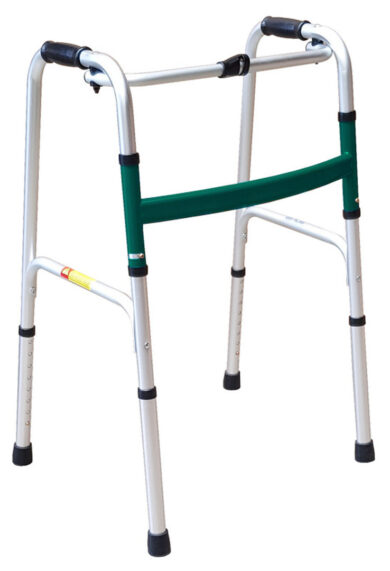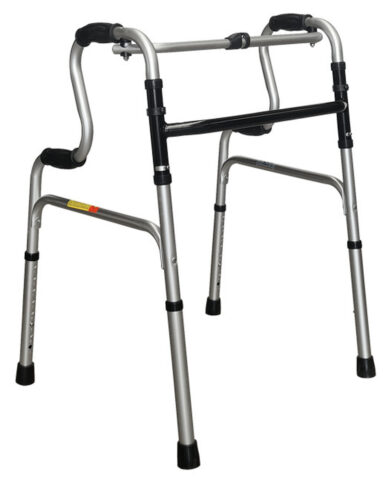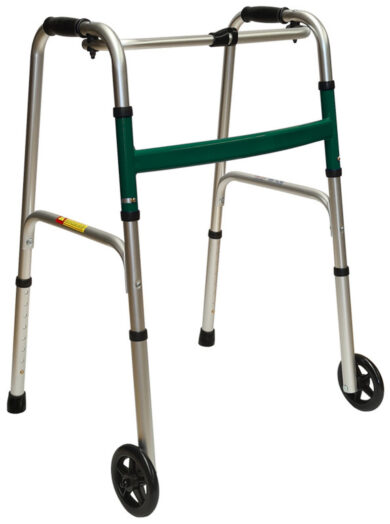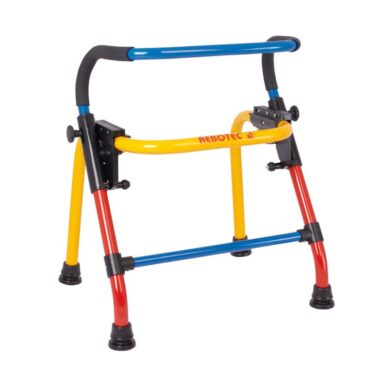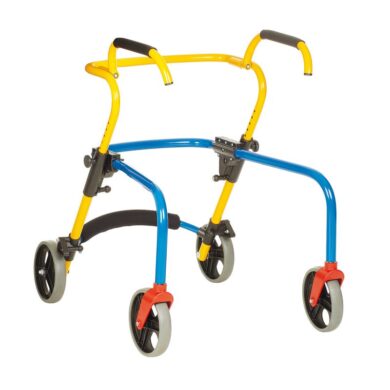Walking Frames
Looking to hire instead? Click here
Loading...
No more products to load.
No more products to load.
Zimmer Walking Frames in Brisbane
At Mobility Rentals & Sales, we have a quality selection of walking sticks, Zimmer frames, crutches & walking frames for sale all covered by our price beat guarantee. Our mobility walkers, Zimmer frames, wheelie walkers and crutches are available for hire in Brisbane & the Gold Coast, and for sale Australia wide.
Shop online or visit our showroom in Woodridge, Brisbane QLD to view our full range.
A walking aid is defined as a mobility device used as an aid for positioning, standing or walking.
This category of walking aids includes walking sticks, crutches, and walking frames, Zimmer frames and sometimes, rollators.
Walking frames (also referred to as a Zimmer Frame, Pulpit Frame or Hopper Frame) are used either as part of a rehabilitation program or as a long term mobility aid where the user has permanent limited mobility. The term Zimmer Frame came about when American company Zimmer Biomet began manufacturing their improved version of the original 1940’s design by William Cribbes Robb. ‘Zimmer Frame’ has since been genericized and is used interchangeably with ‘walking frame’ in Australia
The use of the walking aid is meant to provide the user with confidence and improve posture where the user is recovering from an illness, injury, or operation, and to gradually improve towards independent and unassisted walking.
Purchase or rental of walking aids is generally the result of a referral from your doctor or physiotherapist, who are trained in the assessment and treatment of your disability.
However, if you are becoming increasingly unsteady on your feet, or have joint pains or sore leg muscles, you may find the use of a walking aid beneficial; it is always wise to consult your doctor prior to any course of self treatment.
Walking aids are generally designed to facilitate an improvement in your walking pattern by helping promote upright body posture, as well as better balance and weight distribution, by transferring carry weight from the legs to the arms and shoulders. This can also reduce pain in the lower limbs.
When deciding upon the appropriate walking aid for your condition, there are a number of factors to bear in mind; such as the extent and possible duration of your disability, your living environment, and your lifestyle. Your disability may preclude you achieving permanent independence and this will have a determining effect on the choice of a walking aid. Similarly, if you live in a house with stairs, or steep steps or driveway access; whether you have carpets, loose mats, or tile floors will influence choice. Your occupation, workplace, and after work activities are also significant factors.
In many cases you will use more than the one walking aid to achieve the desired result. For example, if you live in a multi story residence, a walking frame is unsuitable for stairs; crutches or a walking stick are possible alternatives. However, you should always wear appropriate and supportive footwear and never use crutches or walking sticks where there are wet floors.
It is essential that any walking aid be set to the proper height for each user. Failure to do this will make it difficult to straighten your elbows sufficiently which means your arms will not be able to take the proper amount of body weight. If the aid is set too low, it will cause the person to be bent over and promote a poor posture. You should always be measured for the height of your walking aid whilst wearing proper footwear.
Walking Sticks
Also known as canes. The user may use one or two sticks for mobility support.
They are available in wood or metal. Metal walking sticks are generally stronger than wooden walking sticks.
The stick diameter will be dependent on the body weight of the user, the height of the walking stick is determined by the user’s measured hand height from the ground when in a correct upright position.
Folding walking sticks are mostly metal (aluminium) design, having sectioned shafts with an elastic inner cord which enables them to be reduced for easier carrying or storage.
Swan neck walking sticks allow the user’s weight to be centrally transferred over the base of the stick through the offset in the top of the stick, providing improved stability.
Walking sticks with contoured handgrips can benefit users with hand joint problems or sore wrists, as they are variously shaped to provide more hand comfort.
Walking sticks with a seat (aka ‘shooting sticks’) are designed to provide a means of rest when needed, especially of value for people with breathing or heart problems. The seat does tend to alter the stick balance; this, and the added weight and possible difficulty opening and closing the seat, needs to be considered. Some types may not be height adjustable, and the seat may be very small or too low. The most stable seat sticks will have three or four legs, but these will add to the overall weight.
Walking sticks for people with impaired vision are easily recognised by the white colour band usually at the bottom of the cane. They may also have one or more bands of reflective tape. These sticks can be longer than normal in that they are often not needed for support, but are used to ‘feel’ out the user’s surroundings. Such canes can also have a small roller in the tip for increased sensitivity.
Tripod canes and quad canes consist of a shaft and three or four feet, spread apart in different base widths. They are freestanding and more stable than the conventional walking stick. An elbow cuff model is available for even greater support.
Crutches Hire Brisbane & Gold Coast
If you’ve recently suffered an injury that has impaired your ability to walk, we offer affordable crutches hire Gold Coast & Brisbane, to assist your mobility while you recover.
These come in two main types: axilla (or underarm crutches), and elbow crutches. Underarm crutches are mostly used to relieve weight on the leg(s) whilst elbow crutches are used by those who can partially bear weight on the legs.
Crutches can be used singly or as a pair, depending on the injury or medical state of the user.
Underarm crutches have a single or double shaft with the handgrips positioned so the elbows are slightly flexed. Height and distance between the underarm pad and the handgrip is adjustable to ensure a comfortable stance and to permit the proper amount of lower body swing for forward movement. Correct use of underarm crutches is to squeeze the pad against chest and upper arm to avoid pressure on the armpit, which can cause nerve pain and interrupt blood flow.
Elbow crutches can have open or closed cuff styles. Open cuff elbow crutches have a semi circular support to brace the forearm; closed cuff elbow crutches have more like a ring support to prevent the forearm slipping forward and to hold the crutch on the user’s arm at all times. Both styles have adjustments available to ensure comfort and safety in use.
Gutter arm crutches have a trough like armrest to support the user’s weight on the forearms. The gutters are usually well padded and adjustable for comfort and safety.
Canadian crutches are often used as an alternative to axilla crutches, normally by permanent users. Rather than having an underarm pad, the arm is inserted through a padded ring that encircles the upper-arm, providing greater support.
Walking Frames / Zimmer Frames
Zimmer frames / walking frames provide a wide stable platform, mostly used as a rehabilitation aid. The user has to pick up the frame and move it forward, stepping into it to gain a step. The gait is not free flowing, but (rather) jerky in motion. Walking frames may have wheels or no wheels.
Non wheeled walking frames are more stable as they allow the user’s full body weight to bear on all four feet. They are also known as pulpit walking frames, pyramid walking frames, or ‘Zimmer’ frames, and made of steel or aluminium tube, with adjustable height on all legs. They come as fixed frame or folding frame types. Non wheeled walking frames have ferrules on the tip of all four legs, or with glides (skis) on front or back legs.
Fixed walking frames are also known as rigid walking frames. They do not fold, and are the safest configuration.
Folding walking frames are easily stored and transported. The pulpit models hinge from the sides which fold over one another for compactness. They are usually made rigid by either spring loaded locking pins or ‘soft touch’ buttons, either method being easily accessible by the user. Another easier form of release is by pulling on a wooden ball attached to a drawstring on the front of the frame.
Triangular walking frames consist of two parts, hinged at the front, which when folded form a very low profile.
Rigid forearm walkers or gutter arm walkers are a more specialised form of walker usually formed with an attachment to a standard rigid walking frame, consisting of a vertical tube having an adjustable forearm trough (or gutter) and handgrip, which allows the user to bear their weight through their forearm.
Reciprocal frame walkers are made up of three parts, the two sides hinged to the front section so they can be alternately moved forward in the same manner as walking. These frames are more manoeuvrable than rigid ones, but not as stable.
Bi level walking frame has grips located slightly above mid way on the rear legs, which allows the user to more easily pull themselves safely into an upright position preparatory to moving forward. It can have a rigid or folding frame.
Wheeled walking frames are the same as non wheeled walking frames but have two or more wheels in front and ferrules (feet) or glides (skis) on the rear of the frame. The small front wheels make them easier to walk with as only the rear legs need to be lifted to move forward. Small wheels are also available as optional extras for folding and bi level walking frames.
Wheeled walking frames with more than two wheels are nowadays more generally known as rollators, or ‘wheely walkers’.They are available in a wide variety of configurations, usually with proper handgrips, brakes, and other accessories. Wheel sizes are also varied, and should be chosen for the user’s environment. Larger wheels are preferred for uneven ground and outdoor use, smaller wheels for smooth surfaces and indoor use. Accessories includes padded seats, shopping baskets, fixed or fold down trays, cup/drink holders and walking stick holders. Rollators are more commonly used by people who have a greater amount of movement and are in better overall health.
Here at Mobility Rentals & Sales, we have a large selection of mobility walkers available in Brisbane & the Gold Coast. Shop online or visit our showroom in Woodridge, Brisbane to view the full range.
Care of your walking aid equipment
All walking aids equipment should be properly maintained. It should be regularly checked for wear and tear to ensure the safety of the walking aid. Watch for corrosion or rust at the site of screws and height adjustment mechanisms. Ferrules, mostly made of rubber, are particularly susceptible to wear and must be replaced if the base loses definition, or if the rubber shows signs of cracking. Equipment that is height adjustable can show stress signs at the height setting after regular use.
Wheels or castors will wear over time and may need to be replaced, along with the axle pins if they also show signs of wear. Keep pneumatic tyres properly inflated to ensure comfort and safety. Check moving parts such as hinges and joints; if bungy material is used watch for fraying and over stress of the fibres.
Please feel free to contact us to discuss your needs in finding the right Walking Aid to best suit your needs.

